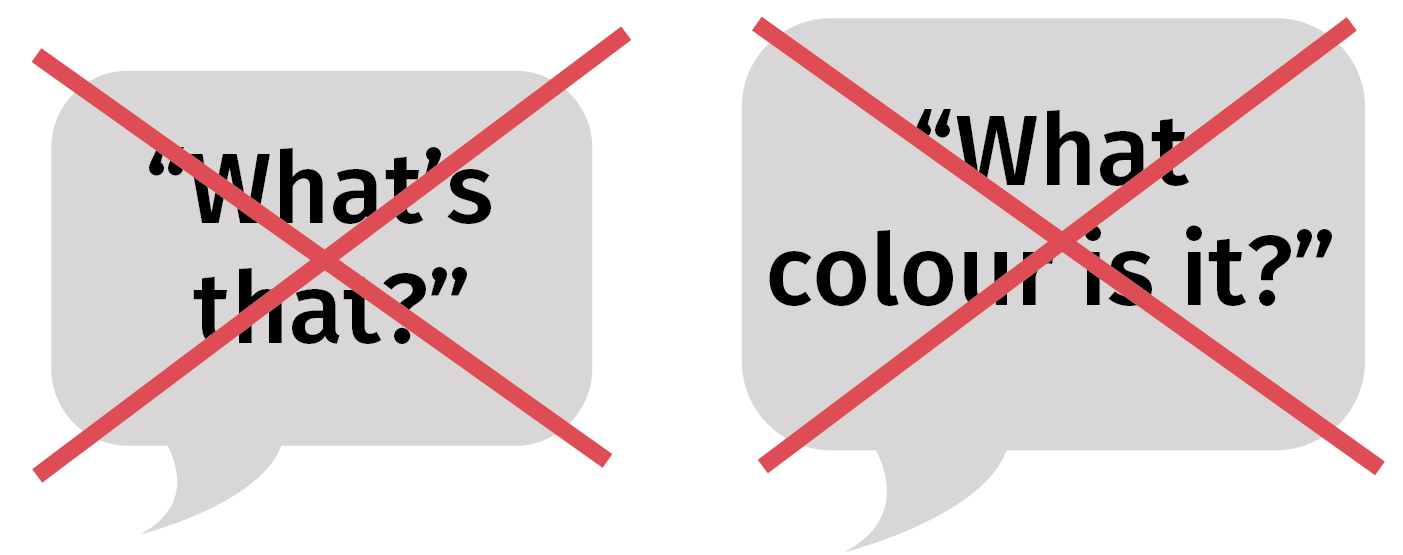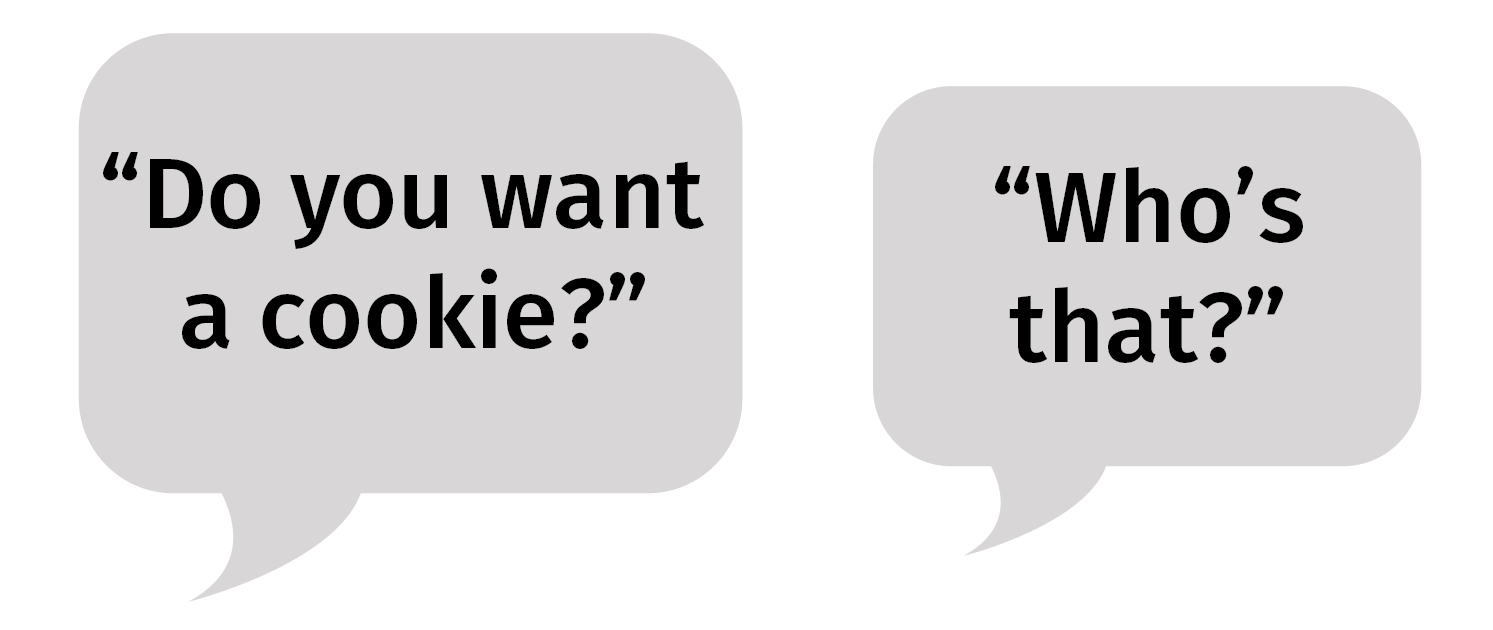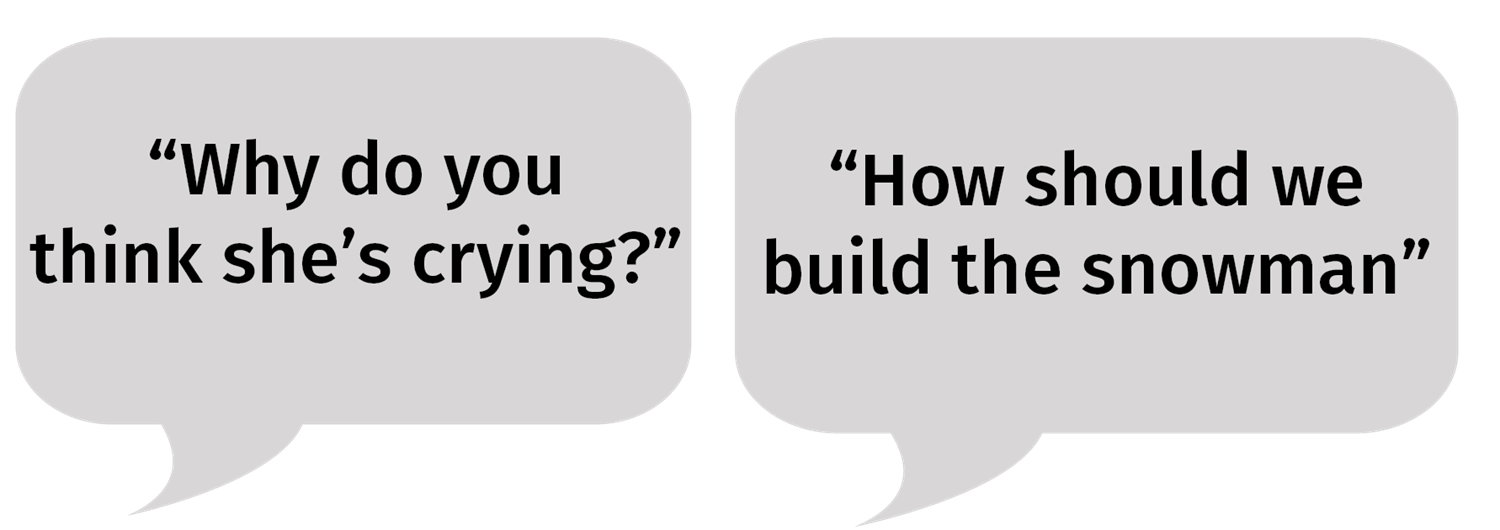Common Questions about Questions

It is likely that at some point in your life you have found yourself in the somewhat awkward situation of having to make conversation with someone you don’t know very well. You probably asked that person some questions, hoping that would keep the conversation going. We use this same strategy with young children, hoping that asking questions will encourage them to talk and help them have little conversations with us. Sometimes this works, but often it doesn’t. Below you’ll find answers to some questions you might have about how to use questions effectively to build your child’s language and conversation skills.
Are questions the best way to encourage my child to talk?
Questions are one way to help children participate in conversation, but there are other ways that are just as (or even more) effective at encouraging children to talk:
- pause and wait – after you do or say something, wait (without saying anything) while looking at your child as if you expect him or her to take a turn in the conversation. Often, if you wait long enough, your child will say something.
- make a comment – instead of asking “What is Goldilocks doing?”, you could turn it into a comment by saying “Oh oh, she broke the chair!”, and then wait for your child to say something. It’s a good idea to balance your questions with comments when interacting with your child to make sure you aren’t bombarding him or her with too many questions.
What are the best questions to ask young children?
We all like to talk about things that interest us, and children are no different. To encourage conversation with your child, your questions need to be sincere and based on his or her interests. If you follow your child’s lead, you will discover what he or she wants to talk about. Asking questions about your child’s experiences is a good way to encourage him or her to take a turn in the conversation.
Questions that aren’t sincere or aren’t based on a child’s interests tend to be “testing questions.” Testing questions are aimed at getting a child to show us whether he or she knows something or not, such as “What colour is it?” or “What’s that?” Asking a lot of testing questions tends to discourage conversation.

Another thing to keep in mind is that questions that encourage conversation are just one small step ahead of a child’s abilities. If your questions are all very easy for your child to answer and don’t require much thought, they won’t encourage his or her language or thinking skills. On the other hand, if your questions are all very challenging, your child will likely feel discouraged or lose interest in interacting with you. So, keep your child’s abilities in mind and ask questions that are just one step ahead. Make sure your child understands your question, and that he or she has the words needed to answer it.
Why does my child give only one-word answers?
Some questions are naturally answered with one word, and others require a longer response. If your child is only answering with a single word, it could be that you are asking the following types of questions:
- Questions that are answered with one word – “Yes/no” questions require a single “yes” or “no” answer. They often start with “Do you…”, such as “Do you want a cookie?” or “Do you like Paw Patrol?”. Some questions that begin with a “wh” word can also be answered with one word, like “What’s that?” or “Who’s that?”.
Questions like this tend to be easier for children and require less thinking. They don’t encourage as much language, so you don’t want to overdo these types of questions with children who are speaking in sentences.

If your child speaks in sentences and you feel like he or she could provide a longer answer, you might consider asking these types of questions:
- Questions that require longer answers – Many questions require longer answers and encourage children to think a bit more. These questions are more open-ended, encourage your child to give an opinion or explanation, and extend his or her thinking beyond the here-and-now. Questions that start with “Why….?”, “How…?”, or “What do you think about…?” often encourage more language, such as “Why do you think she’s crying?” or “How should we build the snowman?”.

How should I react if my child gives the wrong answer?
Sometimes your child won’t know the answer to your question or will give an incorrect answer. When this happens, use it as an opportunity to help your child think and learn. Instead of pointing out that the answer is incorrect, you might try:
- rephrasing the question (e.g. if the original question was “How should we build the snowman?”, try rephrasing like this: “What should we do first – make a big snowball or a little one?”)
- making a comment that provides a hint at the answer (“Hmmm…I’m wondering if the bear was scared.”)
- asking your child for more information (“What makes you think that?”)
When is the best time to ask questions?
You can ask questions any time you interact with your child and want to encourage a back-and-forth conversation. An excellent time to challenge your child with more open-ended questions is when you share books together. Stories provide many new themes and topics, which creates opportunities for thinking and using language in new ways. The pictures give clues that can help your child come up with answers to your questions. Try asking questions that help your child think beyond the pages of the book and tie into his or her own experiences, like: “You went on a bus ride last week, just like Charlie in the story. What did you like about going on the bus?”
My child isn’t talking yet. Should I avoid asking questions??
You can ask your child questions as long as he or she:
- understands your question
- has the ability to answer
Questions can be answered without words by using gestures like nodding and shaking the head, pointing, shrugging shoulders, or giving or showing objects. Here are some examples of questions that can be answered without words:
- Where are your shoes? (can be answered by pointing or going and getting the shoes)
- Do you want some more juice? (can be answered by nodding or shaking head)
- Do you want a cracker or a cookie? (can be answered by pointing to one of the items you are holding)
As long as these are sincere questions that need an answer and are not meant to test your child, these simple questions can encourage your child to answer by using his or her hands and body.
It can be tempting to ask very young children “testing questions” to try to get them to talk. However, testing questions like “What’s that?” or “Who’s that?” tend to frustrate children who don’t know a lot of words because they can’t answer these questions. Instead, focus on following your child’s lead and talking about whatever’s caught his or her attention. This will build your child’s vocabulary.
Asking questions that follow your child’s lead can be a great way to encourage conversations with your child. If your questions are sincere and at your child’s level (or just one step ahead), you will encourage his or her language and thinking skills while having fun talking together!
Similar articles by tag:
